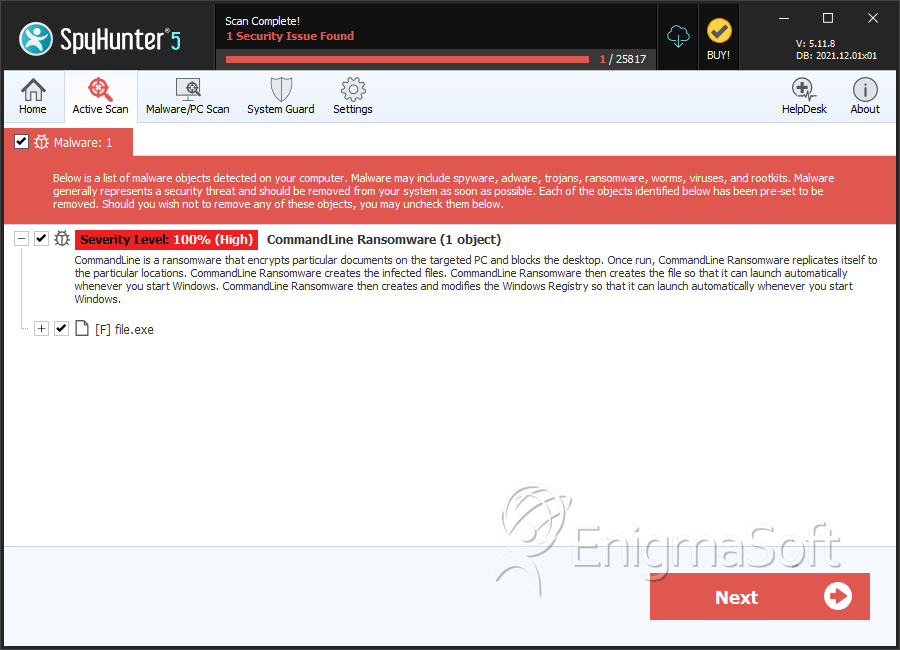CommandLine Ransomware
When someone hears of a ransomware such as the CommandLine Ransomware, they think of a typical ransomware attack like those that have been active in the last year immediately. These threats follow a definite pattern, being distributed through corrupted email messages and then encrypt the victim's files and deliver a ransom note. The CommandLine Ransomware uses a different approach to infect the victim's files, which has prompted speculation about the real purpose of the CommandLine Ransomware infection.
Table of Contents
The Ransomware that Wants do Command Your Finances
The CommandLine Ransomware is not like many other ransomware Trojans in that it is not delivered in a corrupted file that victims click on to activate it. Rather, the CommandLine Ransomware, although packed as an executable file, is designed only to be launched using the Command Line, or Command Prompt in the Windows operating system. Since most computer users need the graphical interface to interact with Windows, this means that the CommandLine Ransomware leverages a part of the Windows operating system that most computer users will never even come into contact with. This makes PC security analysts suspect that the CommandLine Ransomware may not be a completed threat, but that it may be an incomplete or test version of an upcoming ransomware Trojan that will use a graphical interface in its attack. Since the CommandLine Ransomware isn't distributed in a file that users would click, the person installing the CommandLine Ransomware would need to have physical access to the targeted computer, which could also be achieved by using a Remote Access Tool (RAT).
How the CommandLine Ransomware Trojan Works
It's possible that the CommandLine Ransomware is part of an ongoing research on how ransomware spreads. This was seen in other previous infections such as with the ShinoLocker and EduCrypt. The CommandLine Ransomware will encrypt files using the AES encryption algorithm, in the same way as other ransomware Trojans. The CommandLine Ransomware will perform the following actions when it is run:
- Encrypt Files and Delete File
- Encrypt Files and Rename File
- Encrypt Files and Overwrite File
- Decrypt Files
- Decrypt Files except Header
The CommandLine Ransomware also may be programmed to corrupt the infected computer's MBR (Master Boot Record) and delete the Shadow Volume Copies of targeted files. These two features mean that the CommandLine Ransomware has the ability to interfere with how Windows starts up, as well as get rid of file backups that Windows creates. Adding a lock screen or a graphical user interface component to the CommandLine Ransomware would be relatively simple, making it also possible that the CommandLine Ransomware will be evolved into a future threat. The CommandLine Ransomware does not connect to a Command and Control server, in a way similar to the Bucbi Ransomware and other previously observed threats. This is an approach similar to variants of the well-known Crysis Ransomware Trojan, which demands that victims contact an email address to receive payment details.
How Extortionists may Profit with the CommandLine Ransomware Attacks
Ransomware, as their name suggests, generate profits by taking the victim's files hostage in exchange for ransom. The con artists responsible for the CommandLine Ransomware would not give the victim access to the encrypted files until the ransom is paid. Most threats like the CommandLine Ransomware ask for ransom in the range between 0.5 and 1.5 BitCoin, or $300 and $900 USD. PC security analysts do not recommend that victim of the CommandLine Ransomware or other ransomware Trojans pay the ransom. There is no guarantee that the con artists responsible for the CommandLine Ransomware will keep their promise and return the victim's data. In many cases, they will simply ignore the victim or ask for even more money. Apart from this, paying the CommandLine Ransomware's ransom enables these con artists to continue creating and distributing these threats, perpetuating the menace that ransomware Trojans like the CommandLine Ransomware pose to the general public and inexperienced computer users.
SpyHunter Detects & Remove CommandLine Ransomware

File System Details
| # | File Name | MD5 |
Detections
Detections: The number of confirmed and suspected cases of a particular threat detected on
infected computers as reported by SpyHunter.
|
|---|---|---|---|
| 1. | file.exe | 54bed8d032d30df7a066dcb5970f8dfa | 0 |


Submit Comment
Please DO NOT use this comment system for support or billing questions. For SpyHunter technical support requests, please contact our technical support team directly by opening a customer support ticket via your SpyHunter. For billing issues, please refer to our "Billing Questions or Problems?" page. For general inquiries (complaints, legal, press, marketing, copyright), visit our "Inquiries and Feedback" page.